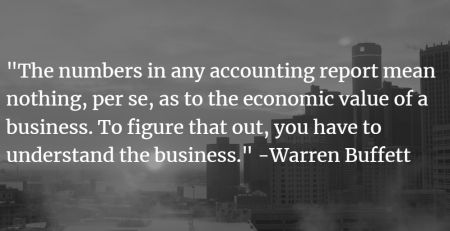First American Financial (FAF): Insurance Without the Payouts (Mostly)
First American Financial Corporation (FAF) is one of the two dominant players (along with Fidelity National Financial, FNF) in the title insurance industry. FAF isn’t exactly the sexiest company – they don’t show up much in the news – but they are the sort of very profitable, dependable, defensible company, providing a keystone service, which tends to be overlooked by many investors seeking something a bit more exciting.
Unlike most insurance policies, which guard against unpredictable future events, title insurance guards against the past, i.e. the risk that the property you are buying may not actually belong to the seller, either because of historical problems with how the title has been recorded or transferred or because there are outstanding liens against the property (think risk prevention, rather than risk assumption).
Under American law, the title of a house is not recorded in a centralized government database. Instead, title records are held in a wide variety of local databases, often consisting of unstandardized records with things like property boundary lines found in hand-drawn maps. This makes these types of records particularly difficult to standardize in order to speed up the title underwriting process.
This is where the title insurers come into play. Over their hundred-plus years of existence, they have been able to build up multiple centuries worth of data in each of their specific geographies in databases called “Title Plants”. The complexity of these title plants, as well as the need to forge relationships with key market participants (real estate agents, bankers, lawyers, etc) has led to the consolidation of the industry into a small group of large players, with very little price competition.
Since title insurance is a policy to protect against the past, a title insurer’s ability to avoid losses is dependent on how well they conduct due diligence. For example, only about 4% of FAF’s premiums go to paying out claims (and these are usually fraud related). 85% or so of the premium (less over time with efficiency gains) goes toward operating expenses. For comparison, a normal property and casualty insurance company has an 80% loss ratio and 20% expense ratio.
FAF has spent much of the last decade bolstering their real estate data assets and extracting efficiencies in their title insurance operations – a formula, which when combined with a slowly improving macro backdrop in housing, has led to an almost 19% EPS (earnings per share) CAGR (compound annual growth rate).
At roughly 11x next year’s earnings, FAF appears to be a very good value (on this simplistic valuation metric). Especially considering we can expect low double-digit total shareholder returns (helped by an almost 3% dividend yield) across their full-cycle economics, in a very well defended market, as well as the upside of putting their excess cash flows and capital to work in a more aggressive manner.
Why does the Opportunity Exist?
Our ability to purchase FAF below what we believe is its intrinsic value comes down to three factors:
- Cycle Fears – skeptics would point out that margins at FAF are above prior peak levels in 2003, which is true, but mortgage originations today are less than half what they were then, so there have clearly been structural efficiency improvements which suggest there is still more room to run. Especially if the currently somewhat lackluster recovery in housing since the great recession gains speed.
- Blockchain Fears – there is a narrative in the market that inefficiencies in the current system will be innovated away through a centralized blockchain system. And while it is true that if we were starting from scratch, a system like this would be preferable, it doesn’t take into account that even if we could agree on a standard, and get everyone on the same tech stack for implementing that standard, at day one when you go to put in the first land transaction, you would still find yourself dependent on the private title plants just to make sure that new standardized record is correct. From day one your problem isn’t that the idea is bad, it’s that there are still decades worth of historical data sitting in filing cabinets and databases somewhere and simply uploading them to the internet wouldn’t eliminate the defects contained within them.
- iBuyer Fears – this is the idea that all real estate transactions will be done by either Zillow or Redfin in the future, and as such, they will have tremendous bargaining power over the title insurers. This thesis fails to realize that title plants would still be extremely valuable in this model, maybe even more so, as the speed of transactions and the ability to automate the title search process will be just as, or more of, a factor for the iBuyer business model (churn inventory quickly) than the price of the title search.
In summation, with FAF we can acquire a very well defended business with strong underlying returns, and even if the macro picture doesn’t improve, we can likely still expect low double-digit returns going forward. If the cycle does improve and efficiencies continue to be extracted from the business, there is room for significant upside.
FAF is a great example of how there remain reasonably undervalued, underfollowed opportunities in interesting places, as long as investors are willing to spend some time searching for them.
Disclosures: This website is for informational purposes only and does not constitute an offer to provide advisory or other services by Globescan in any jurisdiction in which such offer would be unlawful under the securities laws of such jurisdiction. The information contained on this website should not be construed as financial or investment advice on any subject matter and statements contained herein are the opinions of Globescan and are not to be construed as guarantees, warranties or predictions of future events, portfolio allocations, portfolio results, investment returns, or other outcomes. Viewers of this website should not assume that all recommendations will be profitable or that future investment and/or portfolio performance will be profitable or favorable. Globescan expressly disclaims all liability in respect to actions taken based on any or all of the information on this website.
There are links to third-party websites on the internet contained in this website. We provide these links because we believe these websites contain information that might be useful, interesting and or helpful to your professional activities. Globescan has no affiliation or agreement with any linked website. The fact that we provide links to these websites does not mean that we endorse the owner or operator of the respective website or any products or services offered through these sites. We cannot and do not review or endorse or approve the information in these websites, nor does Globescan warrant that a linked site will be free of computer viruses or other harmful code that can impact your computer or other web-access device. The linked sites are not under the control of Globescan, and we are not responsible for the contents of any linked site or any link contained in a linked site. By using this web site to search for or link to another site, you agree and understand that such use is at your own risk.






